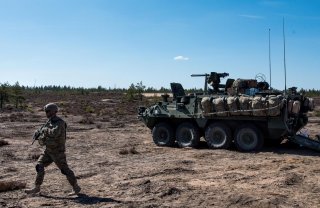by Kris Osborn

The Army is arming up to four large and small prototype combat vehicles with laser weapons engineered to incinerate enemy targets at the speed of light, bringing new tactical dimensions to counter-drone strike, air defenses and precision-guided, scalable offensive land attacks.
Gen. John Murray, Commanding General of Army Futures Command, said the Army is doing experimentation with the laser weapons, with a specific mind to addressing and resolving some of the pressing challenges associated with integrating them into small, mobile or expeditionary platforms.
The Army has for many years now been making progress when it comes to fixed laser weapon applications such as those deployed to protect or fire from a forward operating base or another static location, as they can be powered up and sustained without having to be on-the-move. Vehicle-fired lasers, however, present a new series of complexities.
Murray delineated three major challenges when it comes to building mobile, high-powered laser weapons into combat vehicles, the most pressing of which pertains to a single word … power. Lasers have very high power requirements, which can create challenges when it comes to building a form factor small enough to transport the requisite amount of power needed to fire the weapon effectively.
“You never get 100 percent in, 100 percent out. It is always something less than that. We’ve got some science and technology efforts working now,” Murray explained.
Yet another major obstacle with lasers is thermal management, something of particular relevance should laser weapons be fired in close proximity to soldiers driving combat vehicles, most of which are filled with high-value electronics at risk of overheating.
“Lasers create a tremendous amount of heat. How do you cool it?” Murray asked.
Finally, since they are heavily reliant upon expeditionary sources of power, there needs to be enough energy storage to sustain the weapons system.
“These three problems turn lasers into very big systems. So, if you are putting it on a ship, I mean, you’ve got the room and you’ve got the power. If you are putting it in a fixed facility,
You can build the room and the power. The problem becomes how do you make these things mobile,” Murray said.
While the value-added with lasers is beyond dispute, there are certain limitations that may arise in specific circumstances should, for instance, snow, clouds, fog, sand or heavy rain create some beam attenuation.
“One thing about lasers is they are never going to be the sole solution, because of atmospherics - weather - so you are always going to have some mix of gun, missile and lasers, I think,” Murray explained.
Nonetheless, regardless of challenges and limitations, laser weapon applications continue to show tremendous promise for the Army, particularly when it comes to counter-drone operations, Murray said. Lasers travel at the speed of light, and are scalable, meaning they not only reach and destroy targets at unprecedented speeds, but also can be tailored or scaled to achieve a desired effect such as disabling or fully destroying a target.
The effort continues to gain momentum, as increasingly more highly powered lasers are now firing from Army Stryker vehicles, a promising development likely to inspire new tactical possibilities regarding mobile short-range air defenses against enemy drones, helicopters, lower flying fixed-wing aircraft or even ground targets.
Kris Osborn is the defense editor for the National Interest. Osborn previously served at the Pentagon as a Highly Qualified Expert with the Office of the Assistant Secretary of the Army—Acquisition, Logistics & Technology. Osborn has also worked as an anchor and on-air military specialist at national TV networks. He has appeared as a guest military expert on Fox News, MSNBC, The Military Channel, and The History Channel. He also has a Masters Degree in Comparative Literature from Columbia University.
No comments:
Post a Comment